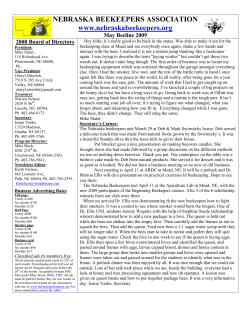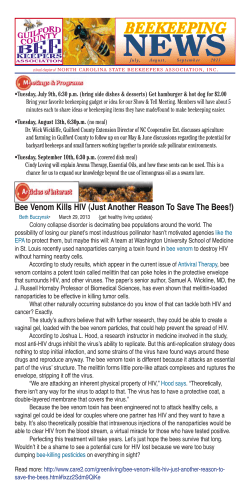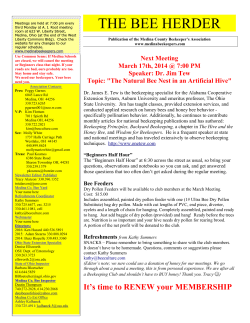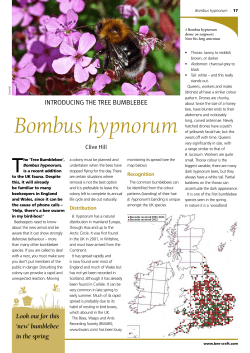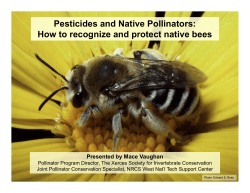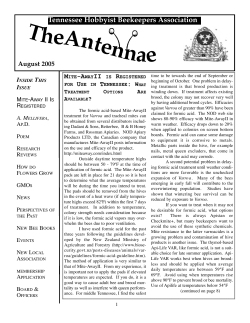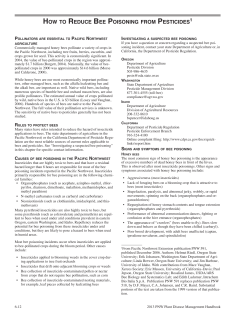
Preparing for Honey Bee Emergencies in Tennessee
PB1522 Preparing for Honey Bee Emergencies in Tennessee Guidelines for emergency personnel to subdue honey bees Table of Contents Danger from sting venom......................................................................................................................3 Allergic reaction......................................................................................................................................3 Normal reaction ......................................................................................................................................3 Abnormal or systemic reaction ...............................................................................................................3 Toxic reaction ..........................................................................................................................................4 Why do bees sting? .................................................................................................................................4 Types of bee emergencies: ...................................................................................................................4 Nests in the “wrong” place ......................................................................................................................4 Moving accidents ....................................................................................................................................4 Africanized bees .....................................................................................................................................4 Swarms ....................................................................................................................................................4 Protective gear .........................................................................................................................................5 Procedures to follow−Questions to ask ...........................................................................................6 How to subdue bees ...............................................................................................................................6 What to do for:..........................................................................................................................................6 Undisturbed swarm.................................................................................................................................6 Disturbed swarm.....................................................................................................................................6 Abandoned colony ..................................................................................................................................6 Bees in a building ....................................................................................................................................6 Rescuing a victim ....................................................................................................................................6 Truck accident.........................................................................................................................................7 Removing stingers ...................................................................................................................................7 Suggestions to prepare your department ........................................................................................7 Video ...........................................................................................................................................................7 2 Preparing for Honey Bee Emergencies in Tennessee Guidelines for emergency personnel to subdue honey bees John A. Skinner, Professor, Entomology and Plant Pathology Life-threatening situations • A truck carrying 150 hives of bees overturns at 5:00 p.m. at a busy intersection in your community and people are being stung. • A beekeeper accidentally kicks two colonies over during a diabetic seizure. • A swarm of bees lands near a school and children are throwing rocks at it. • A person allergic to bee venom discovers bees living in a wall of her house. Is your department prepared to respond immediately to these situations? Life-threatening, bee-related situations are rare, but they do occur. Some situations require immediate response, while others are less serious, requiring an operator to answer a question or refer the call elsewhere. Uncertainty causes delay that may cost the victim’s life. A response must be made quickly, because a person could receive hundreds of stings in a few minutes. Danger from sting venom Honey bees are beneficial when they pollinate our fruits and vegetables. Most people have a normal reaction of localized discomfort when stung, but in some situations, bee stings may cause more serious abnormal or systemic reactions. They can cause problems that are life-threatening. People can die from sting venom due to an allergic reaction (only one or two stings) or a toxic reaction from numerous stings (about 1,000 or more). Allergic reaction Only 5 percent of the population may have a life-threatening allergic reaction to venom. These persons can go into anaphylactic shock and die from one or two stings unless treated immediately. Many people do not know they are allergic. Normal reaction A normal reaction to a sting is localized, with swelling, redness and pain occurring near the sting site. Some people swell more than others. A sting on the wrist may cause the arm to swell up to the elbow. Some people show a delayed reaction, with symptoms appearing one to several hours later. Abnormal or systemic reaction An abnormal or systemic reaction involves generalized symptoms that occur away from the sting site, such as hives, profuse sweating, shortness of breath and tightness of the throat. A victim with these symptoms should be taken immediately to a hospital for treatment. Treatment usually includes a shot of epinephrine. Persons who are aware they are allergic should carry an epinephrine kit, “EPI KIT,” prescribed by their doctor. Epinephrine stabilizes the vascular system, preventing throat swelling 3 that could inhibit breathing. Epinephrine should not be given to a victim who has a heart condition. Abnormal reactions usually occur soon after the person has been stung, but less often, the reaction may be delayed. Toxic reaction A toxic reaction can occur after numerous stings. The venom acts as a poison. The lethal limit for the number of stings a person can sustain varies with weight and health. An adult person of average weight and “good health” may be able to sustain 1,000 stings, while a child weighing much less or an individual in “poor health” may only be able to sustain 200 to 300 stings. Why do the bees sting? Honey bee defense. Honey bees sting to defend the colony that contains their offspring (brood) and food (honey and pollen). When a honey bee stings, an odor (pheromone) is released that stimulates other bees to investigate and sting. A populous colony can have 50,000 worker bees, including numerous guard bees who respond so quickly that an intruder can be stung hundreds of times within one or two minutes. People are more at risk when they disturb a colony they are unaware of, or in a traffic accident with a truck moving colonies. Types of bee emergencies: Nests in the “wrong” place Stinging insects, especially honey bees, often nest in inhabited buildings and other locations where they are not wanted. This situation can be dangerous if a person unexpectedly comes in contact with a colony. A person could accidentally stumble into a nest and be stung. This often occurs with ground-nesting wasps such as yellow jackets. One or two stings may not require attention unless the victim is allergic to venom. A person being stung repeatedly often becomes disoriented and is at great risk if he/she falls down or stands still and swats at the bees. The best defense is to run as quickly as possible to a place that can be sealed tight, leaving the bees outside, such as inside a building or in a car with the windows closed. 4 Moving accidents Thousands of honey bee colonies are transported each year by truck on Tennessee highways moving north from Florida, Mississippi, Georgia and Alabama to locations in New England or Midwestern states for pollination. Several accidents have occurred in Tennessee and elsewhere (Caron et al., 1990: bee spill in Maryland). A beekeeper in Tennessee had a diabetic seizure and accidentally kicked two colonies over. Since he was not able to move away, he was stung repeatedly. Local emergency crews were uncertain how to proceed without putting themselves at risk. The victim in this accident survived after sustaining more than 1,000 stings. Africanized bees The Africanized bee (also called “killer bee”) has migrated into Texas, New Mexico, Arizona, California, Oklahoma, Louisiana, Arkansas and most recently into Florida. Few deaths in the United States have occurred due to Africanized bees. However, incidents of non-lethal stinging have increased. Because of the presence of these bees, fire departments and emergency personnel are receiving numerous calls from people concerned about stinging insects of all kinds. The Africanized bee could reach Tennessee. Swarms of this bee may arrive if they hitch a ride on a truck from an infested area. These hitchhikers could find a nesting site in a hollow cavity of some structure in Tennessee during the warm summer months and become established long before the normal migration. The cavity could be inside an old tire, in a box, in the ground or in an abandoned or sparsely populated honey bee colony. Swarms Swarming occurs in the spring when a colony outgrows its hive. Swarming is the natural mode of reproduction for a honey bee colony. A swarm, including a queen and 10,000 to 30,000 workers, leaves the parent colony in good weather between 10 a.m. and 2 p.m., flies to a nearby tree or bush and lands on a limb. Immediately after landing and for the next 24 to 36 hours, the bees are very docile, because they do not have offspring to defend. Scout bees come out of the cluster and search for a new home. The bees leave the branch and follow the scouts to their new location. Upon arrival, they start to build wax comb and the queen lays eggs, starting a new brood nest. After brood production commences, the new colony will become defensive of their new home. Most swarms can be easily handled by a beekeeper and are not emergencies. While bees are clustered, a beekeeper can usually collect the swarm if it is accessible. Sometimes swarms land high off the ground in eaves of houses or in tops of trees, making them difficult to collect. If not disturbed, the swarm will usually move within 48 hours. A swarm should not be disturbed unless it is being collected by a beekeeper. A disturbed swarm is unpredictable and may become defensive. Protective gear from crawling under your clothing. During an accident, there are many bees on the ground as well as in the air. The bees on the ground will crawl upward on any object that they come in contact with, including you. You need to add a bee veil! A bee veil placed over your head prevents bees from stinging you in the head. Several types of veils are available from bee supply companies. Any type of fine mesh netting that can be tightly secured over your own helmet may work, but it is easier to purchase a folding veil and a standard pith helmet. √ White coveralls over the body – bees react less defensively to “lighter” colors √ Veil to cover head and neck √ Boots – high enough to reach under pant legs √ Duct tape or Velcro® straps to secure pant legs and sleeves √ Leather gloves with long gauntlets that fit over sleeve opening √ Hive tool (8-inch pry bar to remove hive cover and separate hive frames) Emergency situations require using full protective gear to seal any opening, preventing bees from crawling up pant legs or under veils. A white coverall (cotton, Tyvek®, etc.) can be quickly slipped over other clothing. The veil is made of fine wire mesh that prevents bee access while allowing ventilation and clear vision. Veils can be attached directly to the coverall (usually by zipper) or attached to a helmet that is worn over the head and secured with a drawstring over the collar and tied around the waist. For firefighters, the protective equipment you have for fighting fires will protect you from bees or other stinging insects in an emergency. The turnout coat and coveralls are made of heavy fabric with tight closures that will keep bees out. The thick material will prevent stings from reaching skin. Your standard-issue gloves and boots also provide adequate protection; however, you will need to tape the pants tight around your boots and the sleeve of the glove to the sleeve of your coat. This prevents bees Firefighter in turnout gear. He will replace his helmet with a beekeeper’s veil and helmet. He will use beekeeper gloves with a long gauntlet and elastic cuff to keep bees out. 5 The call – Is someone in danger? Is action necessary? What to do for: If there is no danger to human safety, call a beekeeper and have the bees removed alive. Honey bees are valuable and should not be needlessly sacrificed. Ask questions – False alarms are costly and should be avoided. Usually, the local county Extension office can provide names, addresses and phone numbers of beekeepers who live nearby. • Call a beekeeper in to collect it, if possible. A disturbed swarm: Questions to ask: • Who is calling? • Spray foam or detergent mixture in a fan pattern to coat the swarm, and saturate bees on the ground. • What’s happening? ➜ Swarm? ➜ Accident? ➜ Nuisance? ➜ Bees in a wall? • If bees are in flight, make a wall of water and move hose to knock bees out of the air. • Emergency situation? ➜ Is anyone in danger? ➜ Has anyone been stung? An abandoned colony: • Where is the swarm or accident? ➜ Address? ➜ Get directions An undisturbed swarm: • Do nothing – let the swarm move on its own. • Use protective gear. • Remove bystanders. • Get a beekeeper to remove it or, • Has a beekeeper been called to help? • Kill colony by spraying stream of mixture on entrance while covering worker with protective umbrella spray as hive cover is pried off. Additional questions on swarms: • Direct spray inside onto frames and bees. • Where on the property is the swarm? (in a tree? on a building?) Bees in a building: This may be a very challenging situation that will often require the combined efforts of a beekeeper, a carpenter and a pest control operator (please see UT Extension publication 1508, Honey Bees in a Wall). Bees can be trapped alive from the location, if time permits. Foams and sprays will not be effective unless the comb is exposed. This may require removal of a wall or other structure. • How high off the ground is it? (will a ladder be needed?) • How long have the bees been there? (if more than two days, they may be more defensive; more caution will be needed). • How big is the swarm? (football size, etc.). How to subdue or kill bees Use foam or detergent in water The film-forming foam you use to extinguish gasoline and oil fires will kill bees. This foam or liquid detergents act as a wetting agent when added to water. When the mixture is sprayed onto bees, the water clogs the breathing tubes of the bees, suffocating them within one minute. Use a 1 to 3 percent mixture of foam or detergent in water. In a rural situation, the wetting agent can be added directly to the water if a tanker truck is used. In a city, an eductor should be used in the water line to deliver the correct amount of foam/soap. Attach a nozzle to the hose that can deliver either a wide fan pattern or a straight wall of water. 6 • Direct foam spray into all entrances. • Maintain umbrella spray over removal crew. • Open the wall to expose comb and bees. • Spray comb and bees. Rescuing a victim: • Maintain umbrella spray over rescuers. • Spray victim. • Fill surrounding air with covering wall of water. • Remove victim to safe area. • Remove stingers and get medical attention immediately. A truck accident: • Maintain a current list of beekeepers willing to help in emergencies or to collect swarms. Decide if bees are to be saved or killed: • If the situation is not threatening, send a beekeeper. Saved: If the accident area could be temporarily isolated, beekeepers may be used to save bees and reload the truck (see Caron et al). Video available Killed: Use protective gear. • Get as much help as possible – fire and police especially. • The accident area should be cordoned off to prevent onlookers from becoming victims. • Call for wrecker gear and forklifts to move hives, if necessary. • Maintain several protective umbrella sprays on obvious sources of bees. • Rescue any victims. • Continue to spray sources of bees as well as ground and air. Removing stingers The honey bee stinger penetrates the skin and embeds itself because the sting shaft is barbed. The poison sack and attached muscles continue to pump venom into the skin after the bee has departed. The sting and poison sack should be removed by scraping with a thumbnail or other straight-edge as soon as possible to reduce the amount of venom being injected. Do not use tweezers because pressure on the poison sack releases more poison into the victim. Suggestions to prepare your department: • Include this guide in your inservice updates. • Distribute the video mentioned below to local stations. • Provide all personnel with a veil and make sure they know how to use it. • Practice with mock situations or stage a demonstration. • Train dispatchers to ask all the necessary questions. • Contact your local UT Extension office for information about beekeeping. A video, “Controlling Honey Bee Emergencies,” produced by the A.I. Root Company, is strongly recommended to accompany this publication (see references for information about purchasing the video). It demonstrates the proper use of equipment and shows how to handle four types of honey bee emergencies, including an unthreatening swarm, a disturbed swarm, a bee truck accident (overturned colony) and an abandoned colony. Emergency services personnel in Hamilton County recommend it as a valuable resource to prepare for bee-related emergencies. It is important for emergency personnel to understand the stinging insects they need to subdue. Please see references listed below for additional information about bee biology and beekeeping. Beekeepers will often cooperate when asked. With a few precautions, a small amount of new equipment and minimal training, personnel can be prepared to handle stinging insects while reducing risk. References Erickson, E.H. and J.D. Estes. 1992. Fire fighters and paramedics can easily subdue attacking bees and wasps. Amer. Bee J. 132(8): 513-515, 524. Erickson, E.H. 1992. Subduing stinging insects. Bee Culture 120(7): 391-392. Flottum, K., D. Sammataro, P. Moore and J. Ott. 1992. Conducting a honey bee emergency demonstration. Bee Culture 120(7): 393, 396-400. Video Root Productions. 1993. Controlling honey bee emergencies fast. A.I. Root Co., 623 West Liberty St., Medina, OH 44256. (1-800-289-7668). Acknowledgments The author extends appreciation to reviewers Gene Burgess, Deborah Gingrich and Harry Williams; editorial assistance from Jean Ledbetter and pictorial assistance from Danny Delaney (firefighter). 7 Standard turnout gear. With face shield down, bees may still be able to get under the shield. Firefighter wearing gloves and helmet with veil over turnout gear. Standard gloves and boots can be used but any openings at the wrist or ankle should be taped. Visit the UT Extension Web site at http://www.utextension.utk.edu/ PB1522-5M-5/06(Rev) E12-4615-00-007-06 06-0237 Programs in agriculture and natural resources, 4-H youth development, family and consumer sciences, and resource development. University of Tennessee Institute of Agriculture, U.S. Department of Agriculture and county governments cooperating. UT Extension provides equal opportunities in programs and employment.
© Copyright 2025

